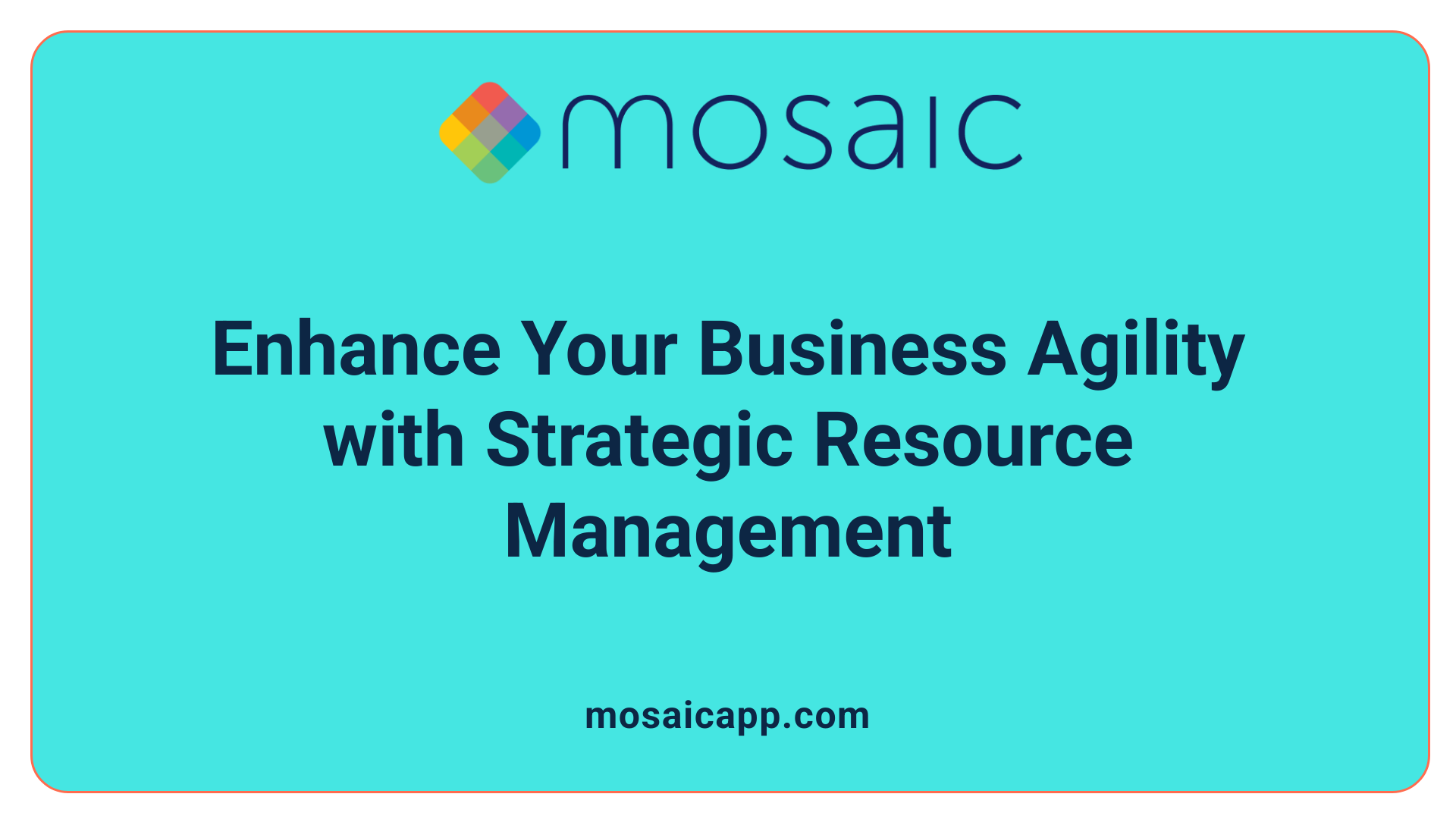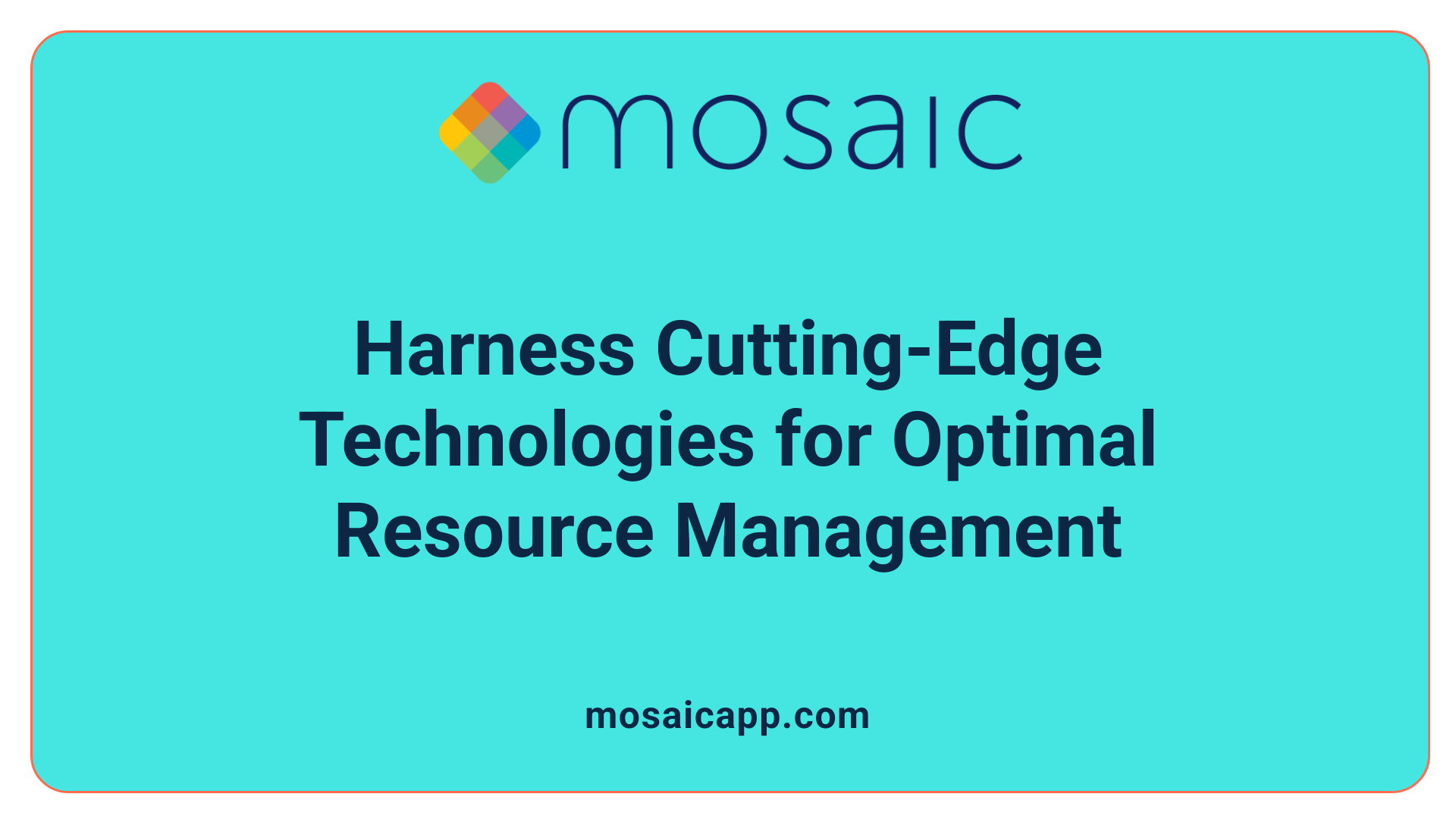Understanding the Foundations of Smart Resource Management
In today’s dynamic business environment, organizations face unprecedented challenges requiring rapid adaptation and resilience. Central to meeting these demands is smart resource management (IRM), a strategic approach that leverages advanced tools, data analytics, and systemic processes. This article explores how IRM enhances organizational agility, operational flexibility, and scalability, ultimately delivering competitive advantages and sustainability.
Defining Smart Resource Management (IRM) and Its Strategic Significance

What is smart resource management (IRM) and why is it important?
Smart resource management (IRM) refers to the use of innovative strategies, digital tools, and data-driven processes to allocate and utilize organizational resources optimally. These resources include personnel, technology, and financial assets.
IRM relies heavily on real-time monitoring, predictive analytics, and systemic analysis to ensure that resources are used effectively. This approach helps organizations respond swiftly to changing conditions, identify potential issues before they escalate, and make informed decisions.
By ensuring that the right resources with the right skills are available at the right time, IRM increases efficiency, reduces waste, and supports the achievement of strategic goals. It helps in balancing workloads, improving productivity, and maintaining sustainability.
This management method is vital for fostering resilient, adaptable organizations that can compete in dynamic markets. It also plays a crucial role in reducing operational costs, minimizing risks, and promoting long-term growth. Overall, IRM is essential for operational excellence and aligning resource deployment with organizational and environmental objectives.
| Aspect | Description | Significance |
|---|---|---|
| Resource Allocation | Using digital tools and data insights to distribute resources efficiently | Ensures timely availability of skills and assets, boosting project success |
| Real-time Monitoring | Continuous tracking of resource usage and performance | Facilitates swift decisions to adapt to changing conditions |
| Predictive Analytics | Forecasting future needs and potential issues | Prevents disruptions and optimizes planning |
| Strategic Alignment | Connecting resource management with organizational goals | Maintains focus on long-term sustainability and competitive advantage |
Implementing IRM empowers organizations to operate more efficiently, reduce costs, and build a robust environment adaptable to future challenges.
The Impact of Resource Management on Business Agility

How does resource management influence organizational agility?
Resource management plays a crucial role in shaping a company's ability to adapt and respond quickly to changing market conditions. When organizations manage their talent and resources effectively, they can reconfigure their workforce swiftly to meet emerging demands.
Strategic workforce planning, such as maintaining a current skills inventory and implementing flexible staffing models, allows firms to allocate human resources where they are needed most. Continuous learning and development initiatives ensure employees are equipped with relevant skills, making the organization more resilient and responsive.
Fostering a culture of openness, innovation, and employee empowerment boosts agility by encouraging quick decision-making and collaborative problem-solving. Clear communication and alignment with strategic objectives help teams adapt with less disruption.
Technology tools, such as automation, intelligent resource management (IRM), and real-time data analytics, further support agility. These tools enable organizations to anticipate change, optimize resource deployment, and stay competitive.
In summary, resource management influences organizational agility by ensuring the right capabilities are in place, facilitating rapid adaptation, and promoting a flexible, engaged workforce that can respond effectively to evolving business environments.
Connecting Resource Practices with Operational Flexibility and Scalability

How do resource management practices promote flexibility and scalability?
Effective resource management directly impacts an organization’s ability to adapt and grow in a dynamic environment. When firms implement flexible resource allocation strategies and employ automated workflows, they enable rapid adjustments to changing project demands and market conditions. For example, using agile resource management allows teams to reassign personnel or reconfigure workflows quickly, preventing delays and bottlenecks.
Automation tools, such as real-time data tracking and digital twin technology, facilitate seamless scaling of operations. These tools help identify capacity gaps or surplus in real-time, allowing organizations to adjust resources efficiently without sacrificing performance.
Moreover, continuous reassessment and human-centered management ensure that resource deployment aligns with evolving business priorities, enhancing responsiveness. Having a dedicated resource planning team that maintains an up-to-date skills inventory further supports scalable and flexible operations.
What technological advances support these practices?
Recent technological developments significantly bolster resource management practices that promote flexibility and growth.
Cloud-Based Solutions and Infrastructure Management Services (IMS):
- Enable rapid resource scaling through elastic computing.
- Support automation of provisioning and lifecycle management.
- Provide cost control and security enhancements.
Industrial Internet of Things (IIoT):
- Connects machines and sensors to gather real-time operational data.
- Allows remote management and swift reconfiguration of assets.
- Facilitates data-driven decision-making and predictive maintenance.
Digital Twin Technology:
- Creates virtual replicas of physical assets and operations.
- Supports scenario testing and process optimization before physical deployment.
- Accelerates scaling and operational adjustments with minimal risk.
Advanced Control and Embedded Systems:
- Offer granular control over processes.
- Enable quick reconfiguration and modular system architecture.
AI and Machine Learning (ML):
- Analyze operational data to identify patterns and forecast issues.
- Enhance responsiveness by recommending optimal resource deployment.
Automation and DevOps Practices:
- Automate deployment, patching, and monitoring.
- Accelerate development cycles and improve security.
By harnessing these technological advances, organizations can create a resilient, adaptable foundation that supports both operational flexibility and scalable growth. Starting with high-impact use cases and ensuring proper integration and staff training are crucial steps in this process.
Strategic Advantages of Implementing Smart Resource Management
Implementing smart resource management provides organizations with several important strategic benefits. Foremost, it significantly enhances operational efficiency by ensuring that resources are allocated optimally, reducing waste, and lowering overall costs. This proactive approach to resource use leads to more streamlined workflows and better project outcomes.
Additionally, digital tools such as the Internet of Things (IoT), digital twins, and advanced analytics are central to these systems. IoT connects machines, sensors, and systems to deliver real-time data, enabling immediate insights into operational conditions. Digital twins create virtual replicas of physical assets or processes, allowing teams to simulate scenarios, test adjustments, and make informed decisions before implementing changes in the real world.
Analytics and AI-driven systems analyze the collected data, identify patterns, and provide predictive insights. These technologies facilitate anticipatory action, risk mitigation, and continuous process optimization.
Overall, smart resource management allows organizations to plan more accurately, respond rapidly to changes, and maintain a competitive edge. It also supports sustainability efforts by enabling lifecycle assessments and optimizing resource use over time. In summary, adopting these systems fosters innovation, improves resilience, and aligns resource deployment with strategic goals, ensuring long-term growth and market adaptability.
Implementing Technologies for Effective Resource Management

How can organizations implement smart resource management effectively?
Organizations aiming to enhance their resource management capabilities can harness a range of advanced technologies to achieve better efficiency and sustainability. Central to this approach are tools like artificial intelligence (AI), Internet of Things (IoT) sensors, digital twins, and cloud computing services.
AI and data analytics enable real-time data processing, pattern recognition, and predictive insights. This allows companies to forecast demand, anticipate issues, and optimize resource allocation dynamically. IoT devices, such as sensors embedded in machinery or infrastructure, provide continuous monitoring of physical assets, ensuring timely maintenance and efficient operation.
Digital twins create virtual replicas of physical assets or systems, allowing organizations to simulate various scenarios and test solutions before physical implementation. Combining these technologies fosters proactive decision-making and rapid response to operational changes.
Successful implementation also involves adopting systemic strategies rooted in sustainability principles, such as the circular economy. This encourages resource conservation, recycling, and refurbishing, reducing waste and supporting long-term resilience.
Establishing clear processes and policies is fundamental, along with fostering a culture of continuous improvement and collaboration. Resource-sharing platforms facilitate cross-sector cooperation and knowledge exchange. Furthermore, integrating renewable energy sources and optimizing energy consumption through smart grids and demand response initiatives contribute to sustainable resource practices.
In addition, organizations need to consider societal and ethical factors, ensuring their resource management aligns with broader sustainability aims and is socially responsible. Addressing policy implications and promoting ethical resource utilization can bolster community trust and compliance.
Overall, the effective adoption of these technologies relies on strategic planning, stakeholder engagement, ongoing training, and a focus on sustainability, making resource use more efficient, resilient, and aligned with future societal needs.
Technology-Driven Enhancements for Business Resilience and Performance
How do automation, proactive security, and cloud management contribute to business efficiency?
Automation plays a pivotal role in increasing operational efficiency by reducing human error, speeding up processes, and enabling rapid deployment of new services. Automated provisioning, using Infrastructure-as-Code, accelerates system setup and updates, while continuous monitoring and automated failover mechanisms protect against outages and downtime.
Proactive security measures, including continuous threat detection, encryption, and compliance tools, reduce risks of data breaches and operational disruptions. These security protocols ensure that systems are resilient, compliant, and capable of supporting ongoing business activities without interruption.
Cloud management strategies, such as multi-region architectures and real-time resource scaling, enhance scalability and flexibility. Cloud-native tools, automation, and FinOps practices help control costs and optimize resource utilization. Partnering with cloud providers like Parachute ensures expert guidance in security, cost management, and operational resilience.
Together, these technological advancements streamline operations, safeguard assets, and enable organizations to adapt swiftly to market changes, supporting sustained growth and performance.
Benefits like cost control, scalability, and security
Implementing smart technologies yields several benefits that directly impact business performance. Cost control is achieved through automation and real-time expense monitoring, reducing waste and ensuring efficient use of resources.
Scalability allows organizations to expand or contract operations seamlessly, driven by elastic cloud resources that respond to demand instantly. This agility supports growth initiatives and market responsiveness.
Enhanced security practices, including automated threat detection and continuous compliance, safeguard digital assets and ensure operational continuity. This respect for security minimizes risks and maintains customer trust.
By integrating these technological enhancements, organizations build resilient, agile, and cost-effective infrastructures that facilitate long-term success.
| Aspect | Description | Impact |
|---|---|---|
| Automation | Use of infrastructure-as-code, automated provisioning, and monitoring | Faster deployment, reduced errors, improved efficiency |
| Security | Continuous threat detection, encryption, compliance tools | Reduced risk of breaches, increased trust |
| Cloud Management | Multi-region architectures, real-time scaling, FinOps | Enhanced scalability, cost savings, resilience |
| Overall Benefits | Cost control, scalability, security, agility | Improved performance, lower costs, market adaptability |
Exploring these technological advances reveals how organizations can become more resilient and competitive in today's fast-changing business environment.
Technological Innovations Enhancing Resource Management and Organizational Agility
How do technological advancements enhance resource management and organizational agility?
Recent developments in technology have transformed how organizations manage their resources and adapt to changing environments. Tools powered by Artificial Intelligence (AI), data analytics, and cloud computing enable companies to achieve greater transparency and efficiency.
AI and machine learning algorithms analyze vast amounts of data from resumes, performance reviews, and project histories through platforms like Workday’s Skills Cloud. This continuous data gathering helps build a detailed skills inventory that guides better workforce deployment. Similarly, intelligent resource management (IRM) systems harness machine learning across various data points to optimize decisions about staffing, project assignments, and talent development.
The adoption of cloud technologies allows organizations to scale operations rapidly and flexibly. Cloud platforms provide real-time visibility into operational metrics, facilitate rapid provisioning using Infrastructure-as-Code, and support automation that reduces manual work and human error. Elastic cloud resources can be scaled up or down instantly depending on market demand, allowing businesses to respond swiftly to new opportunities or disruptions.
The Industrial Internet of Things (IIoT) connects machines, sensors, and systems to enable continuous monitoring. This connectivity allows for predictive maintenance, remote management, and quick reconfiguration of assets, which enhances operational agility. Digital twin technology offers virtual replicas of physical assets or processes, permitting testing of different scenarios to improve efficiency before physical implementation. These advancements support rapid decision-making and risk mitigation.
By integrating AI, IoT, and cloud management strategies, organizations are better equipped to analyze operational data, identify patterns, and make proactive adjustments. Real-time insights improve responsiveness and help in predicting outcomes, thus fostering an environment where resources are used optimally and organizational flexibility is maximized.
| Technology | Functionality | Impact on Resource Management and Agility |
|---|---|---|
| AI & Data Analytics | Analyzes large datasets for optimized decision-making | Improves forecasting, planning, and resource allocation |
| Cloud Computing | Scalable and on-demand infrastructure | Enables rapid scaling, remote access, and continuous operation |
| IoT & IIoT | Connects physical assets for real-time data | Supports predictive maintenance, quick reconfiguration |
| Digital Twins | Creates virtual simulations of physical systems | Facilitates testing, scenario analysis, and process optimization |
Together, these innovations allow organizations to work smarter, respond faster, and adapt more seamlessly to their environment. Strategic implementation of these technologies, coupled with ongoing staff training and process reviews, builds resilience and prepares organizations for future challenges.
The Strategic Power of Strategic, Tech-Enabled Resource Management
In conclusion, smart resource management—bolstered by technological innovation and strategic planning—is fundamental to building resilient, agile organizations capable of thriving amid disruption. By leveraging data analytics, real-time insights, and automation, organizations can optimize resource deployment, foster innovation, and respond swiftly to shifting market demands. Emphasizing continuous improvement, human-centered practices, and sustainability, IRM not only enhances operational performance but also provides a sustainable competitive edge. Ultimately, organizations that invest in developing their resource management capabilities, supported by cutting-edge technology, position themselves for long-term success in an increasingly volatile world.
References
- Why Intelligent Resource Management Matters
- Agility & Scalability: The Competitive Edge in Smart ...
- What Are the Benefits of Building Business Agility?
- Agile Resource Management: 5 Best Practices for Dynamic ...
- Enhancing Project Agility: Adapting Resources to ...
- How Smart Cloud Management Fuels Agility and Cost Control
- What is Resource Management and Why Is It Important?


